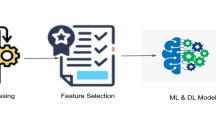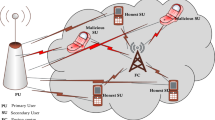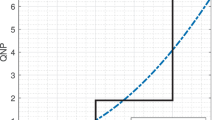Abstract
The space division multiple access–orthogonal frequency division multiplexing (SDMA–OFDM) wireless system has become very popular owing high spectral efficiency and high load capability. The optimal maximum likelihood multiuser detection (MUD) technique suffers from high computational complexity. On the other hand the linear minimum mean square error (MMSE) MUD techniques yields poor performance and also fails to detect users in overload scenario, where the number of users are more than that of number of receiving antennas. By contrast, the differential evolution algorithm (DEA) aided minimum symbol error rate (MSER) MUD can sustain in overload scenario as it can directly minimizes probability of error rather than mean square error. However, all these classical techniques are still complex as these do channel estimation and multiuser detection sequentially. In this paper, complex multi layer perceptron (CMLP) neural network model is suggested for MUD in SDMA–OFDM system as it do both channel approximation and MUD simultaneously. Simulation results prove that the CMLP aided MUD performs better than the MMSE and MSER techniques in terms of enhanced bit error rate performance with low computational complexity.






Similar content being viewed by others
References
Prasad, R. (2004). OFDM for wireless communications systems. London: Artech House Inc. Publications.
Oestges, C., & Clerckx, B. (2007). MIMO wireless communications: From real-world propagation to space-time code design. California, USA: Acadamic Press.
Hanzo, L., Munster, M., Choi, B. J., & Keller, T. (2003). OFDM and MC-CDMA for broadband multi-user communications, WLANs and broadcasting. West Sussex, England: IEEE Press/Wiley Publications.
Vandenameele, P., Perre, L. V. D., Engels, M., Gyselinckx, B., & Man, H. D. (2000). A combined OFDM/SDMA approach. IEEE Journal on Selected Areas in Communications, 18(11), 2312–2321.
Verdu, S. (1998). Multiuser detection. Cambridge, UK: Cambridge University Press.
Jiang, Ming, & Hanzo, L. (2007). Multiuser MIMO–OFDM for next-generation wireless systems. Proceedings of the IEEE, 95(7), 1430–1469.
Wolniansky, P. W., Foschini, G. J., Golden, G. D., & Valenzuela, R. A. (1998). V-BLAST: An architecture for realizing very high data rates over the rich-scattering wireless channel. In international symposium on signals, systems and electroinics (pp. 295–300).
Foschini, G. J., & Gans, M. J. (1998). On limits of wireless communications in a fading environment when using multiple antennas. Wireless Personal Communications, 6, 311–335.
Kim, K. J., Yue, J., Iltis, R. A., & Gibson, J. D. (2005). A QRD-M/Kalman filter-based detection and channel estimation algorithm for MIMO–OFDM systems. IEEE Transactions on Wireless Communications, 4(2), 710–721.
Kim, J.-S., Moon, S.-H., & Lee, I. (2010). A new reduced complexity ML detection scheme for MIMO systems. IEEE Transactions on Communications, 58(4), 1302–1310.
Arar, M., & Yongacoglu, A. (2006). Efficient detection algorithm for 2Nx2N MIMO systems using alamouti code and QR decomposition. IEEE Communications Letters, 10(12), 819–821.
Damen, M., Abed-Meraim, K., & Belfiore, J.-C. (2000). Generalized sphere decoder for asymmetrical space-time communication architecture. IEEE Electronic Letters, 36(2), 166–167.
Hochwald, B., & ten Brink, S. (2003). Achieving near-capacity on a multiple-antenna channel. IEEE Transaction on Communications, 51(3), 389–399.
El-Khamy, M., Vikalo, H., Hassibi, B., & McEliece, R. J. (2009). Performance of sphere decoding of block codes. IEEE Transactions on Communications, 57(10), 2940–2950.
Alias, M. Y., Samingan, A. K., Chen, S., & Hanzo, L. (2003). Multiple antenna aided OFDM employing minimum bit error rate multiuser detection. IEEE Electronics Letters, 39(24), 1769–1770.
Alias, M. Y., & Chen, S. (2005). Multiple-antenna-aided OFDM employing genetic-algorithm-assisted minimum bit error rate multiuser detection. IEEE Transactions on Vehicular Technology, 54(5), 1713–1721.
Jiang, M., & Hanzo, L. (2004). Genetically enhanced TTCM assisted MMSE multi-user detection for SDMA-OFDM. In Proceedings of the 2004 IEEE 60th vehicular technology conference (Vol. 3, pp. 1954–1958).
Haris, P. A., Gopinathan, E., & Ali, C. K. (2010). Performance of some metaheuristic algorithms for multiuser detection in TTCM-assisted rank-deficient SDMA-OFDM system. EURASIP Journal on Wireless Communications and Networking. doi:10.1155/2010/473435.
Haris, P. A., Gopinathan, E., & Ali, C. K. (2011). Artificial bee Colony and Tabu search enhanced TTCM assisted MMSE multi-user detectors for rank deficient SDMA–OFDM system. Wireless Personal Communications. doi:10.1007/s11277-011-0264-0.
Zhang, J., Chen, S., Mu, X., & Hanzo, L. (2012). Turbo multi-user detection for OFDM/SDMA systems relying on differential evolution aided iterative channel estimation. IEEE Transactions on Communications, 60(6), 1621–1633.
Zhang, J., Chen, S., Mu, X., Hanzo, L. (2012). Differential evolution algorithm aided minimum symbol error rate multi-user detection for multi-user OFDM/SDMA system. In Proceedings of IEEE vehicular technology conference (pp. 1–5).
Ko, K. B., Choi, S., & Kang, C. (2001). RBF multiuser detector with channel estimation capability in a synchronous MC–CDMA system. IEEE Transactions on Neural Networks, 12(6), 1536–1539.
Chuah, T. C., Sharif, B. S., & Hinton, O. R. (2002). Robust CDMA multiuser detection using a neural-network approach. IEEE Transactions on Neural Networks, 13(6), 1532–1539.
Shayesteh, M. G., & Hamidreza, A. (2003). Neural networks for multiuser detection of signals in DS/CDMA systems. Neural Computing & Applications, 11(3–4), 178–190.
Zheng, Z.-W. (2009). Receiver design for uplink multiuser code division multiple access communication system based on neural network. Wireless Personal Communications, 53(1), 67–79.
Taspinar, N., & Cicek, M. (2011). Neural network based receiver for multiuser detection in MC–CDMA systems. Wireless Personal Communications. doi:10.1007/s11277-011-0462-9.
Patra, J. C., Meher, P. K., & Chakraborty, G. (2009). Nonlinear channel equalization for wireless communication system using Legendre neural network. Signal Processing, 89(11), 2251–2262.
Burse, K., Yadav, R. N., & Shrivastava, S. C. (2010). Channel equalization using neural networks: A review. IEEE Transactions on Systems, Man, and Cybernetics, 40(3), 352–357.
Benvenuto, N., & Piazza, F. (1992). On the complex backpropagation algorithm. IEEE Transactions on Signal Processing, 40(4), 967–969.
Nitta, T. (1997). An extension of the back-propagation algorithm to complex numbers. Neural Networks, 10(8), 1391–1415.
Erceg, V., Hari, K. V. S., Smith, M. S., Baum D. S., et al. (2001). Channel models for fixed wireless applications. Contribution in IEEE 802.16.3c-01/29r1.
Author information
Authors and Affiliations
Corresponding author
Appendix: Development of the Complex BP Algorithm for CMLP Network Training
Appendix: Development of the Complex BP Algorithm for CMLP Network Training
During the proposed CMLP network training, the conventional BP algorithm cannot be applied directly as all connection weights and biases are complex in form. For BP algorithm to be applied for CMLP network training, it is required to compute the gradient of the instantaneous error with respect to real and imaginary components of all network weights and biases. Thus, the modifications incorporated in this algorithm are derived as follows. Figure 7 represents a typical training model of CMLP model with \(Q\) number of layers each consisting \(n\) neurons. Let, \(g_n^q \) is the activation output of the \(n\)th neuron in the \(q\)th layer, then the net activation value of the \(n\)th neuron in the \(q\)th layer is given by:
where \(g_n^q =SGM\left( {s_n^q } \right) \), and \(n\) = 0 refers to the bias input: i.e. \(g_0^q =1\). Also, when \(q\) = 0, then \(g_n^0 , n=1,2,\ldots ,N_0 \) refers the input signal. Assuming \(g_n^q =u_n^q +jv_n^q \),
The superscripts \(R\) and \(I\) corresponds to real and imaginary values, respectively. In the complex BP algorithm, the network weights are adjusted such that the error in the output layer is minimized. Hence, the sum squared global instantaneous error at the output layer ‘\(Q\)’ is expressed as:
where \(e_n =d_n -g_n^Q , n=1,2,\ldots ,N_Q \) and \(d_n \) is the desired response. The gradient of \(E\) with respect to \(g_n^q \) is:
Similarly, the gradient of \(E\) with respect to \(s_n^q \) is:
From Eqs. (28) and (29), the error gradient of \(n\)th neuron in the \(q\)th layer is derived as:
Since the weight vector in complex valued, the gradient of instantaneous error can be obtained by calculating the gradient of the error with respect to both the real and imaginary components of the \(W_{nm}^q \), which is according to:
Using the chain rule,
In the above equations
From above equations \(\nabla _{W_{nm}^q } E\) can be obtained as:
where (.)\(^{*}\) denote the complex conjugate. The correction \(\Delta W_{nm}^q \) applied to \(W_{nm}^q \) is defined by delta rule as:
where \(\mu \) is the learning parameter.
The generalized error gradient for \(q=Q,Q-1,\ldots ,1\) and \(n=1,2,\ldots ,N_q\) as:
Rights and permissions
About this article
Cite this article
Bagadi, K.P., Das, S. Multiuser Detection in SDMA–OFDM Wireless Communication System Using Complex Multilayer Perceptron Neural Network. Wireless Pers Commun 77, 21–39 (2014). https://doi.org/10.1007/s11277-013-1492-2
Published:
Issue Date:
DOI: https://doi.org/10.1007/s11277-013-1492-2





